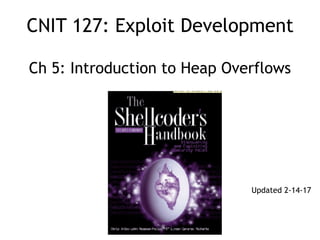CNIT 127 Ch 5: Introduction to heap overflows
•
1 gostou•1,918 visualizações
Slides for a college course at City College San Francisco. Based on "The Shellcoder's Handbook: Discovering and Exploiting Security Holes ", by Chris Anley, John Heasman, Felix Lindner, Gerardo Richarte; ASIN: B004P5O38Q. Instructor: Sam Bowne Class website: https://samsclass.info/127/127_S17.shtml
Denunciar
Compartilhar
Denunciar
Compartilhar
Baixar para ler offline

Recomendados
Mais conteúdo relacionado
Mais procurados
Mais procurados (20)
CNIT 126 2: Malware Analysis in Virtual Machines & 3: Basic Dynamic Analysis

CNIT 126 2: Malware Analysis in Virtual Machines & 3: Basic Dynamic Analysis
"15 Technique to Exploit File Upload Pages", Ebrahim Hegazy

"15 Technique to Exploit File Upload Pages", Ebrahim Hegazy
Hadoop Architecture | HDFS Architecture | Hadoop Architecture Tutorial | HDFS...

Hadoop Architecture | HDFS Architecture | Hadoop Architecture Tutorial | HDFS...
Practical Malware Analysis: Ch 11: Malware Behavior

Practical Malware Analysis: Ch 11: Malware Behavior
Destaque
Destaque (20)
CNIT 127 Lecture 7: Intro to 64-Bit Assembler (not in book)

CNIT 127 Lecture 7: Intro to 64-Bit Assembler (not in book)
CNIT 121: 12 Investigating Windows Systems (Part 2 of 3)

CNIT 121: 12 Investigating Windows Systems (Part 2 of 3)
CNIT 121: 12 Investigating Windows Systems (Part 3)

CNIT 121: 12 Investigating Windows Systems (Part 3)
CNIT 121: 4 Getting the Investigation Started on the Right Foot & 5 Initial D...

CNIT 121: 4 Getting the Investigation Started on the Right Foot & 5 Initial D...
CNIT 121: 6 Discovering the Scope of the Incident & 7 Live Data Collection

CNIT 121: 6 Discovering the Scope of the Incident & 7 Live Data Collection
CNIT 129S: 13: Attacking Users: Other Techniques (Part 1 of 2)

CNIT 129S: 13: Attacking Users: Other Techniques (Part 1 of 2)
Semelhante a CNIT 127 Ch 5: Introduction to heap overflows
Semelhante a CNIT 127 Ch 5: Introduction to heap overflows (20)
(Berkeley CS186 guest lecture) Big Data Analytics Systems: What Goes Around C...

(Berkeley CS186 guest lecture) Big Data Analytics Systems: What Goes Around C...
Optimizing Performance - Clojure Remote - Nikola Peric

Optimizing Performance - Clojure Remote - Nikola Peric
Thorny Path to the Large Scale Graph Processing, Алексей Зиновьев (Тамтэк)

Thorny Path to the Large Scale Graph Processing, Алексей Зиновьев (Тамтэк)
Thorny path to the Large-Scale Graph Processing (Highload++, 2014)

Thorny path to the Large-Scale Graph Processing (Highload++, 2014)
Accelerate Reed-Solomon coding for Fault-Tolerance in RAID-like system

Accelerate Reed-Solomon coding for Fault-Tolerance in RAID-like system
Mais de Sam Bowne
Mais de Sam Bowne (20)
Último
Mattingly "AI & Prompt Design: The Basics of Prompt Design"

Mattingly "AI & Prompt Design: The Basics of Prompt Design"National Information Standards Organization (NISO)
“Oh GOSH! Reflecting on Hackteria's Collaborative Practices in a Global Do-It...

“Oh GOSH! Reflecting on Hackteria's Collaborative Practices in a Global Do-It...Marc Dusseiller Dusjagr
Último (20)
Mattingly "AI & Prompt Design: The Basics of Prompt Design"

Mattingly "AI & Prompt Design: The Basics of Prompt Design"
Separation of Lanthanides/ Lanthanides and Actinides

Separation of Lanthanides/ Lanthanides and Actinides
Interactive Powerpoint_How to Master effective communication

Interactive Powerpoint_How to Master effective communication
Z Score,T Score, Percential Rank and Box Plot Graph

Z Score,T Score, Percential Rank and Box Plot Graph
“Oh GOSH! Reflecting on Hackteria's Collaborative Practices in a Global Do-It...

“Oh GOSH! Reflecting on Hackteria's Collaborative Practices in a Global Do-It...
Measures of Central Tendency: Mean, Median and Mode

Measures of Central Tendency: Mean, Median and Mode
18-04-UA_REPORT_MEDIALITERAСY_INDEX-DM_23-1-final-eng.pdf

18-04-UA_REPORT_MEDIALITERAСY_INDEX-DM_23-1-final-eng.pdf
Industrial Policy - 1948, 1956, 1973, 1977, 1980, 1991

Industrial Policy - 1948, 1956, 1973, 1977, 1980, 1991
TataKelola dan KamSiber Kecerdasan Buatan v022.pdf

TataKelola dan KamSiber Kecerdasan Buatan v022.pdf
Call Girls in Dwarka Mor Delhi Contact Us 9654467111

Call Girls in Dwarka Mor Delhi Contact Us 9654467111
CNIT 127 Ch 5: Introduction to heap overflows
- 1. CNIT 127: Exploit Development Ch 5: Introduction to Heap Overflows Updated 2-14-17
- 2. What is a Heap?
- 3. Memory Map • In gdb, the "info proc map" command shows how memory is used • Programs have a stack, one or more heaps, and other segments • malloc() allocates space on the heap • free() frees the space
- 5. Heap Structure Size of previous chunk Size of this chunk Pointer to next chunk Pointer to previous chunk Data Size of previous chunk Size of this chunk Pointer to next chunk Pointer to previous chunk Data Size of previous chunk Size of this chunk Pointer to next chunk Pointer to previous chunk Data
- 8. Viewing the Heap in gdb
- 10. Crash in gdb
- 11. Targeted Exploit
- 12. The Problem With the Heap
- 13. EIP is Hard to Control • The Stack contains stored EIP values • The Heap usually does not • However, it has addresses that are used for writes – To fill in heap data – To rearrange chunks when free() is called
- 14. Action of Free() • Must write to the forward and reverse pointers • If we can overflow a chunk, we can control those writes • Write to arbitrary RAM – Image from mathyvanhoef.com, link Ch 5b
- 15. Target RAM Options • Saved return address on the Stack – Like the Buffer Overflows we did previously • Global Offset Table – Used to find shared library functions • Destructors table (DTORS) – Called when a program exits • C Library Hooks
- 16. Target RAM Options • "atexit" structure (link Ch 4n) • Any function pointer • In Windows, the default unhandled exception handler is easy to find and exploit
- 17. Project Walkthroughs • Proj 8 – Exploiting a write to a heap value • Proj 8x – Taking over a remote server • Proj 5x – Buffer overflow with a canary
